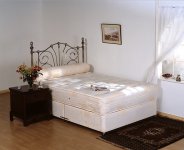I have a shoot planned in a very old museum in my village, it's so great a place that the BBC even used it for filming a period drama set in the 1700s I belive it was. They even dressed it up a bit more and added in lime plaster walls and aged it to the point where you would be mistaken if you were not actually back in time.
I have a shoot planned and want to make it look like a Rembrandt painting. The model has a very interesting DNA makeup which is really going to add to the pictures.
I wanted people's thoughts on lighting.
Keeping in with Rembrandt, it naturally has to have a huge element of chiaroscuro for dramataic lighting.
I am going to use different scrims to block light out, as we will be shooting in early morning for hopeful deep warm sun (still using scrims to block out or use colour scrim to add warmths).
I also wanted to shoot with lots of candle lighting (not in the shot, but to illuminate and add warmth top skins).
I will only have one flash gun (AD200) but may try to borrow another for very soft fill light.
There will be lots of diffusion and very low light pops to make sure i get that soft 'painterly' look (when not using solley candles).
I will experiment will all of the above.
Has anyone ever tried to make their portraits look like a Rembrandt painting? Any examples you want to post up?
Any tips on equipment?
I will be using my Canon 5DMK3, 70-200ii, Rollie Carbon tripod and geared head for fine tuning, AD200 with diffusion (though I do not own a soft box or octobox - may get one for this shoot).
Picture is of the location. (obvioulsy it's very bright here, was just a phone pic on a scouting mission).
I have a shoot planned and want to make it look like a Rembrandt painting. The model has a very interesting DNA makeup which is really going to add to the pictures.
I wanted people's thoughts on lighting.
Keeping in with Rembrandt, it naturally has to have a huge element of chiaroscuro for dramataic lighting.
I am going to use different scrims to block light out, as we will be shooting in early morning for hopeful deep warm sun (still using scrims to block out or use colour scrim to add warmths).
I also wanted to shoot with lots of candle lighting (not in the shot, but to illuminate and add warmth top skins).
I will only have one flash gun (AD200) but may try to borrow another for very soft fill light.
There will be lots of diffusion and very low light pops to make sure i get that soft 'painterly' look (when not using solley candles).
I will experiment will all of the above.
Has anyone ever tried to make their portraits look like a Rembrandt painting? Any examples you want to post up?
Any tips on equipment?
I will be using my Canon 5DMK3, 70-200ii, Rollie Carbon tripod and geared head for fine tuning, AD200 with diffusion (though I do not own a soft box or octobox - may get one for this shoot).
Picture is of the location. (obvioulsy it's very bright here, was just a phone pic on a scouting mission).










